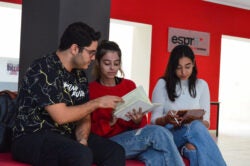 The class of first-year students studying English at Tokat Gaziosmanpaşa University in Turkey includes a refugee student from Syria, an exchange student from Nigeria, several Turkish students, and a woman from Turkmenistan – all English language learners. They are paired with a class of graduate and doctoral students at Old Dominion University in the southern United States. This class, a course on Virtual International Education, is diverse, too: a provost at a U.S. community college, an international student from Asia, and a military-affiliated student with children and limited international experience, among others. Despite their unique backgrounds, they had in common their participation in a dialogue-based exchange in spring 2022. Their virtual exchange experiences have been both challenging and eye-opening, despite their differences in age, professional experience, and nationality – or perhaps because of them.
The class of first-year students studying English at Tokat Gaziosmanpaşa University in Turkey includes a refugee student from Syria, an exchange student from Nigeria, several Turkish students, and a woman from Turkmenistan – all English language learners. They are paired with a class of graduate and doctoral students at Old Dominion University in the southern United States. This class, a course on Virtual International Education, is diverse, too: a provost at a U.S. community college, an international student from Asia, and a military-affiliated student with children and limited international experience, among others. Despite their unique backgrounds, they had in common their participation in a dialogue-based exchange in spring 2022. Their virtual exchange experiences have been both challenging and eye-opening, despite their differences in age, professional experience, and nationality – or perhaps because of them.
Why a class on virtual exchange?
In response to canceled study abroad programming due to COVID-19 concerns, my department presented me with the opportunity to teach a special topics course that would attract students from our master’s and doctoral program in higher education and the doctoral program in community college leadership. Previously, my co-researcher Kimberley Cossey and I had engaged in research on virtual exchanges at U.S. community colleges, focusing on the impact of the pandemic. I was eager to share my experiences from that research in a class on Virtual International Education, which includes but goes beyond virtual exchange. A key component of this class would be for students to experience a virtual exchange firsthand and to gain cross-cultural communication skills, cultural empathy, and awareness, which are critical skills for international educators of today. By engaging in a virtual exchange themselves, I hoped that students would get a glimpse into the successes and the challenges of students participating in a virtual exchange. As future higher education administrators and educators, this potentially impactful experience could then possibly lead to the students implementing virtual international education initiatives at future institutions. Student participation in a virtual exchange could also have the potential to reinforce learning outcomes for this course, such as the development of cross-cultural knowledge and skills, including communication across borders, time-zones, and languages.
Structure of the class
When I crafted the course outline for this special topics course, I knew I would need to include two days on virtual exchange pedagogy and models. In my reading, I noticed that virtual exchange is not only COIL (a type of virtual exchange known as Collaborative Online International Learning), but also models like East Carolina University’s Global Understandings approach, and several other models developed at individual institutions. But the course also included modules on virtual study abroad, virtual internships, assessment, virtual programs portfolio development, partnership development, and, of course, the Stevens Initiative. The students would be asked to present on two higher education systems in other countries as preparation for finding possible virtual exchange partners one day, and they would be asked to develop a proposal for a virtual international program portfolio at an institution of their choice.
In order to incorporate virtual exchange into my course, I needed a partner. After some outreach, I received an email from a faculty member at a Turkish university who was also a member of the COIL network and interested in creating a virtual exchange we could implement in our two classes. We met on Zoom and instantly clicked. With great excitement, we chiseled out the details for the virtual exchange component. Because our courses were different and the only commonality was the virtual exchange our students would participate in, we needed to design a mutually beneficial virtual exchange that met our individual class objectives. Unlike my class on virtual international education, my partner’s students would be enrolled in an English speaking skills class, so the most logical exchange would be a dialogue-based exchange. We chatted about the overlap of our two semesters and goals for the exchange, and settled on eight one-hour conversations for our student pairs.
As other virtual exchange implementers have thought about when recruiting participants, I wondered whether there would be enough ODU student interest for my class to run. As it turns out, there was. I contacted the ten registered students with a draft syllabus one month prior to the semester start, informing them of the virtual exchange component, which would require extensive out of class time. I shared with them my excitement for this class and explained that the course would allow them to enhance their cross-cultural communication skills and add an applied lived experience component to the course. I offered this information ahead of the semester start so they would have time to determine if the class was of interest to them and that their schedules would permit them to participate. To my pleasant surprise, not one student dropped the class.
Learnings
My virtual exchange journey has been a wonderful experience. My partner had similar interests for the exchange, and she was communicative and excited. We are currently in the process of carrying out a study about our students’ experiences with virtual exchange, and this experience led me to unexpectedly make a new professional friend.
On the student side, I learned the experience was equally impactful. On the last day of class, students shared about their virtual exchanges, what they learned, and what they would improve for a second rendition of the class. Students shared examples of what they learned about Turkish culture and its people. Some of them had listened to Turkish music or watched Turkish movies recommended by their exchange partners. Others had friended their partners on social media and at least one made plans to stay in touch once the exchange was completed. Comments like “it was a really awesome experience” or “I really enjoyed my time” abounded throughout the presentations. One student explained that “talking to someone who has a different perspective than you[r own] is really important,” which drives home the importance of virtual exchange, and confirms the reason I chose to embed it in this class.
But my main take-away from their presentations was that students wanted more: They wished for higher stakes, such as a collaborative project or a joint presentation. They wanted a tangible product from their exchange beyond the weekly conversations. This makes me hopeful for the future of virtual exchange: students such as the ones in my class are hungry to make connections and collaborate with students in other countries. They’ll make connections with diverse others, perhaps, as one of my students described it, to “talk about the philosophies of life.” But they also grow in cultural self-awareness, effective communication, and their cultural worldview and knowledge. For my students, Turkey is now not just a faraway place, but rather one with the face of a first-year student in an English class.
Heidi Fischer, Ph.D. is a visiting assistant professor of higher education at Old Dominion University. She came to the U.S. as an international student from Germany to pursue undergraduate and graduate education. Previously, she worked in the education abroad field in the university setting.
 The class of first-year students studying English at Tokat Gaziosmanpaşa University in Turkey includes a refugee student from Syria, an exchange student from Nigeria, several Turkish students, and a woman from Turkmenistan – all English language learners. They are paired with a class of graduate and doctoral students at Old Dominion University in the southern United States. This class, a course on Virtual International Education, is diverse, too: a provost at a U.S. community college, an international student from Asia, and a military-affiliated student with children and limited international experience, among others. Despite their unique backgrounds, they had in common their participation in a dialogue-based exchange in spring 2022. Their virtual exchange experiences have been both challenging and eye-opening, despite their differences in age, professional experience, and nationality – or perhaps because of them.
The class of first-year students studying English at Tokat Gaziosmanpaşa University in Turkey includes a refugee student from Syria, an exchange student from Nigeria, several Turkish students, and a woman from Turkmenistan – all English language learners. They are paired with a class of graduate and doctoral students at Old Dominion University in the southern United States. This class, a course on Virtual International Education, is diverse, too: a provost at a U.S. community college, an international student from Asia, and a military-affiliated student with children and limited international experience, among others. Despite their unique backgrounds, they had in common their participation in a dialogue-based exchange in spring 2022. Their virtual exchange experiences have been both challenging and eye-opening, despite their differences in age, professional experience, and nationality – or perhaps because of them.